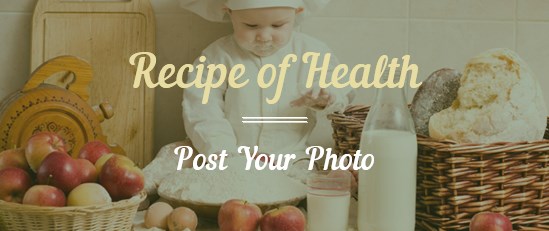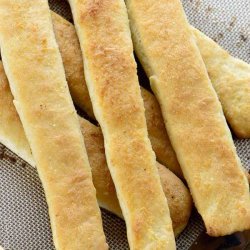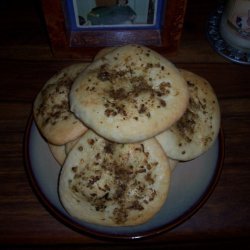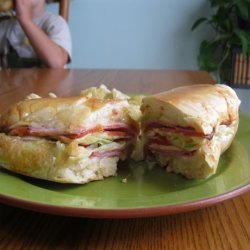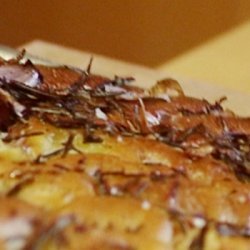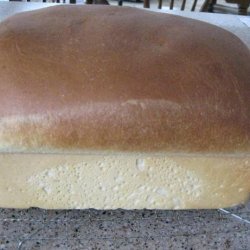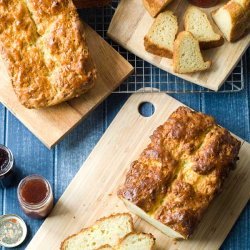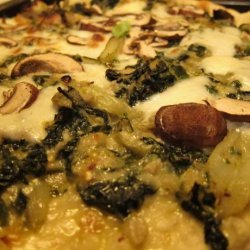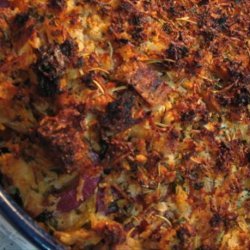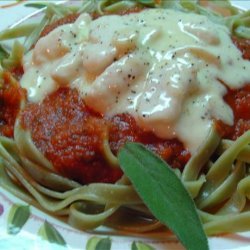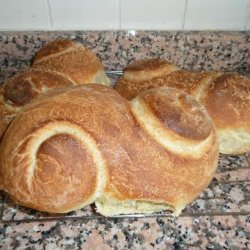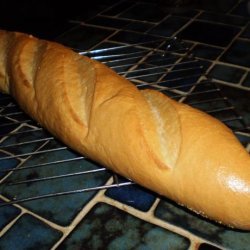Directions:
- Part 1, (A day ahead of time).
- 2 Cups hot water (tap hot, not heated. Mustn’t be over about 120º or it will kill the yeast.
- 2 tsp yeast. This is a scant package. I buy yeast in bulk (like a pound) and keep it in the freezer, where it’ll stay usable for a few years, so I can use 2 tsps at a time. A package is normally about 2-3/4 teaspoons (I think).
- 1/2 tsp barley malt. Barley malt is a thick, golden liquid sugar substitute. This tiny bit (it’s not a mistake for 1/2 Tbsp) will add a lovely flavor to the crust. It should be available at your local ‘health food’ store. Keep it in the refrigerator so that it doesn’t grow mold, unless you end up making pizza two or three times a week, which would use up one of those little jars of barley malt before mold becomes a worry. It’s a pain to use when it’s cold. I add it to the hot water first, which gets it off the spoon (a problem) and also brings down the temperature of the water a bit (for yeast safety).
- 2 Cups bread flour - higher gluten (protein) content than regular all-purpose flour.
- 1 tsp gluten flour, which will raise the gluten content to the right point, making the crust really chewy. Also available at a ‘health food’ store.
- Mix the water, yeast, and barley malt together. Get that yeast dissolved by stirring fairly gently. Use a big mixing bowl, Let them sit while you get the flour and gluten flour out from wherever you keep them. You should be seeing the liquid getting a little frothy on top. Add in the flours and mix well, beating them a bit for a few minutes to incorporate air (possibly just to feel good about being actively involved and to get them well mixed). Cover with a damp kitchen cotton towel (not a fuzzy, which would be harder to clean if the sponge [which is what is in that bowl] rises enough to touch the towel), and let it sit out on the counter for a day. Don’t refrigerate. This is a fermentation process, which develops and matures (great word) the dough, greatly enhancing the flavor. (I found out about this from a great little book of cookery essays, ‘Home Cooking’, by Laurie Colwin.) It also gives the yeast time to multiply, which is why we used so little yeast at the beginning. In fact, it will be even better if you let it sit for two days, which will make the fermentation more powerful and the dough even better tasting. If I were going to let it sit for two days rather than one I’d probably cut the yeast down to 1 teaspoons Check the sponge at the end of the first day, if you’re going for two. If it looks like it’s going to bubble up to the towel, you might stir in another half-cup of flour, to slow things down a bit. Also, get the towel damp again if it’s dried out.
- Part 2, (A couple or three hours before supper.)
- Take the sponge, which should still be very wet and gooey, and stir in, mixing well (If you don’t you’ll end up with clumps of salt or Mrs. Dash in your crust, and you won’t like that.):.
- 2 Tbsp (or so) olive oil.
- 2 Tbsp salt.
- 2 Tbsp (or so) dried basil.
- A couple of dashes of Mrs. Dash garlic un-salt.
- It’s really nice if you have a powerful mixer. I found a Kitchen Aid at a second-hand store and that’s what you need – if the mixer’s not built for kneading bread dough you’ll just burn it out, and doing it by hand is not so awful. People have done it and enjoyed doing it for thousands of years after all.
- Add flour in a half-cup or a cup at a time (add a cup until you see that you’re getting close, then switch to the half-cup) until the dough pulls away cleanly from the mixing bowl or until it’s not sticking to your hands too much. If you’re using a mixer, then mix it at medium speed for about five minutes. If you’re doing it by hand, turn out the dough onto a floured board and knead it until it feels like a baby’s ass. All those books blather about feeling silky-smooth and so on, but they mean like a baby’s ass. Cover with the moistened towel and let sit for about 1/2 hour. Divide the dough into two halves and re-cover one while you stretch the other. You could use a rolling pin, but that would squeeze too much gas out of the bubbles – better dough if you just stretch. I use 2 cookie sheets, and I oil them lightly with olive oil. I pull the dough until it’s about the size and shape of the sheet. I then cover it with that towel and let it rest while I work on the second half of the dough. It needs to rest about 15 minutes. This lets the gluten relax. If it doesn’t get that chance, the dough will contract for a while after you stretch it out to size. While this is happening, I oil the pans (cookie sheets in my case) lightly with olive oil.
- Stretching takes a bit of practice, but it’s not like you have to toss it up, spinning, in the air. I gently flatten what was a ball of dough into a disk. “Gently?” Well, there are some times when you take dough and slam it down on a breadboard. This is not one of them. After I get it into a rough circle of about eight to ten inches in diameter. I hold the dough with both hands, holding it about an inch in from the circumference, with my hands at about 10:00 and 2:00, and I let the dough hang down, using its weight to stretch it. I move it around in its circle by moving my hands, bringing them together, changing grips and moving them apart. The point is to try to get the dough thinner and still maintain an even thickness. The edge remains thicker than the interior. You want that because the edge is where it’s most likely to tear, until the center starts to get pretty thin. I keep checking the size against the size of the pan I’m going to use. When it’s getting pretty close I put the dough on the pan and then turn it upside-down and put it back on the pan. This puts a light coating of oil on the top side of the dough. I then stretch the dough the rest of the way, pulling along the edges to thin them down a bit. I end up with edges that are somewhat thicker than the middle portion of the pizza, but I like that. I keep a small container (a bouillon cup or a pudding cup) of water nearby, and if the dough pulls apart I very lightly moisten the edges of the hole and glue them back together.
- Cover the crusts with that ol’ moistened towel and let rise for 1/2 hour or so. Do what you do for topping, and put in a pre-heated 475º oven until crust at edge is golden brown. I use two racks and switch the pans up and down about half-way through. Cooking time is about 12 minutes, usually.
- If you want to make it even better, go to Home Depot and get two 12 x 12 Saltillo floor tiles. They are thick and unglazed, and you just lay one on each oven rack. They act as heat reservoirs. It will take about 45 minutes to heat the oven, and you can go through the torture of trying to bake the pizza on those tiles, but it’s just about as good to put the pans on top of the tiles. The tiles will make sure that the oven stays hot while you put the pizzas in, and they will see to it that the bottom of the pizza gets its share of the heat. It really improves the pizza, but I have to admit that I don’t bother, myself. I did it for a long time, but it got tiresome to find a place to put the tiles when they’re not in the oven, and I found myself breaking them too often, moving them around. They’re cheap enough, as opposed to the hoity-toity pizza stones they sell in “gourmet” stores, which are too thin to do any good.
- Mangia bene!
Nutrition Facts
| Amount Per 1 Serving | |||
| Calories | 749.14 Kcal (3136 kJ) | ||
| Calories from fat | 97.31 Kcal | ||
| % Daily Value* | |||
| Total Fat | 10.81g | 17% | |
|---|---|---|---|
| Sodium | 3561.2mg | 148% | |
| Potassium | 241.2mg | 5% | |
| Total Carbs | 138.39g | 46% | |
| Sugars | 0.05g | 0% | |
| Dietary Fiber | 3.98g | 16% | |
| Protein | 23.46g | 47% | |
| Vitamin C | 0.2mg | 0% | |
| Iron | 7.7mg | 43% | |
| Calcium | 46.7mg | 5% | |
| Amount Per 100 g | |||
| Calories | 227.47 Kcal (952 kJ) | ||
| Calories from fat | 29.55 Kcal | ||
| % Daily Value* | |||
| Total Fat | 3.28g | 17% | |
|---|---|---|---|
| Sodium | 1081.33mg | 148% | |
| Potassium | 73.24mg | 5% | |
| Total Carbs | 42.02g | 46% | |
| Sugars | 0.01g | 0% | |
| Dietary Fiber | 1.21g | 16% | |
| Protein | 7.12g | 47% | |
| Vitamin C | 0.1mg | 0% | |
| Iron | 2.3mg | 43% | |
| Calcium | 14.2mg | 5% | |
* Percent Daily Values are based on a 2000 calorie diet. Your daily values may be higher or lower depending on your calorie needs.
Find out how many calories should you eat.
Get Your Recipe of Health!
Follow RecipeOfHealth on Facebook!

